Beret made of mohair with knitting needles Even a novice craftswoman can knit. And the patterns for creating a headdress with a detailed description will help you understand the technique of making patterns.
Properties of mohair that need to be taken into account when knitting a beret with knitting needles
Mohair yarn is quite popular among knitters, because it is very light, almost weightless, and when worn, items made from such thread give a pleasant feeling and warmth.
In addition, such yarn has many advantages that distinguish it from ordinary wool, for example:
- elasticity;
- strength;
- natural moderate shine;
- hygroscopicity;
- elasticity;
- resistant to pollution;
- hypoallergenic;
- volume;
- has good thermal insulation properties.
The wool of Angora goats is mohair. It is usually mixed with natural or synthetic thread. Because yarn that consists only of goat hair is not produced. Since it is not durable, it falls apart into hairs, and does not retain its shape.
The content of goat wool in the yarn is no more than 83%, which ensures the strength and reasonable cost of mohair.
Experienced craftswomen consider knitting with mohair thread to be quite easy and profitable, since it is characterized by good pliability. Therefore, work with such yarn progresses very quickly. Any patterns, ornaments, especially openwork ones, are obtained.
However, despite all the advantages of mohair, there are some nuances when working with such a thread.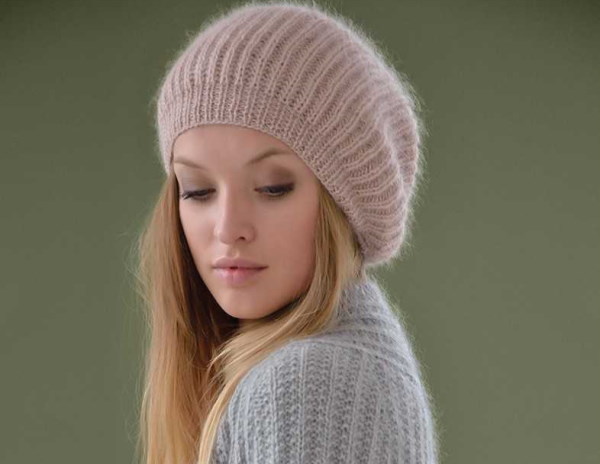
According to professional craftswomen, knitting needles are best suited for knitting with mohair. Since the external attractive qualities of this yarn are somewhat reduced if the knitting is dense.
For example, experienced knitters who can precisely regulate the knitting density can even use a hook or a fork.
Long pile can roll (fell) if the knitting is very tight. Models knitted with loose knitting using knitting needles will not look very fluffy.
To ensure that knitting is free and even, you should study the recommendations of experienced craftswomen:
- The knitting needles are chosen to be slightly larger in diameter than those used for the thickness of a regular wool thread. Then the structure of the mohair product will be more airy and delicate.
- Mohair fabric is translucent at any knitting density. This yarn simply has this feature. However, the warming properties of the knitted model do not decrease.
- Schemes, ornaments, knitting patterns are chosen taking into account the specific qualities of mohair. The item may turn out shapeless if the pattern is very delicate.
- Preference should be given to tight knitting or choose a denser lace. This way the product will hold its shape better.
- When starting knitting, the mohair thread is connected to a spool of the same color. This will keep the shape of the headdress well.
- When buying yarn, perform a couple of techniques. To check the strength of the thread twist, its end is pulled. And the skein is squeezed by hand - this will determine how the threads squeak. Which will tell the percentage of added synthetic fibers.
Fashionable models of women's berets
A mohair beret with knitting needles (description and patterns will help you create a unique item with your own hands) is easy to knit. This is one of the most fashionable accessories in a woman's wardrobe this season.
Stylists have prepared for fashionistas various variations of berets, which are considered an absolute trend this year.
Classic beret
For the cold season, a classic beret in a neutral beige tone is suitable. Stylists advise wearing it with a laconic coat, a puffy leather jacket, or a short sheepskin coat.
This headdress also goes well with a fur coat. It is complemented with a cashmere stole, a thin scarf, and elegant leather gloves.
Pastel mohair beret
As you know, winter looks need light and bright colors. A mohair beret in a pastel shade will help transform such an outfit.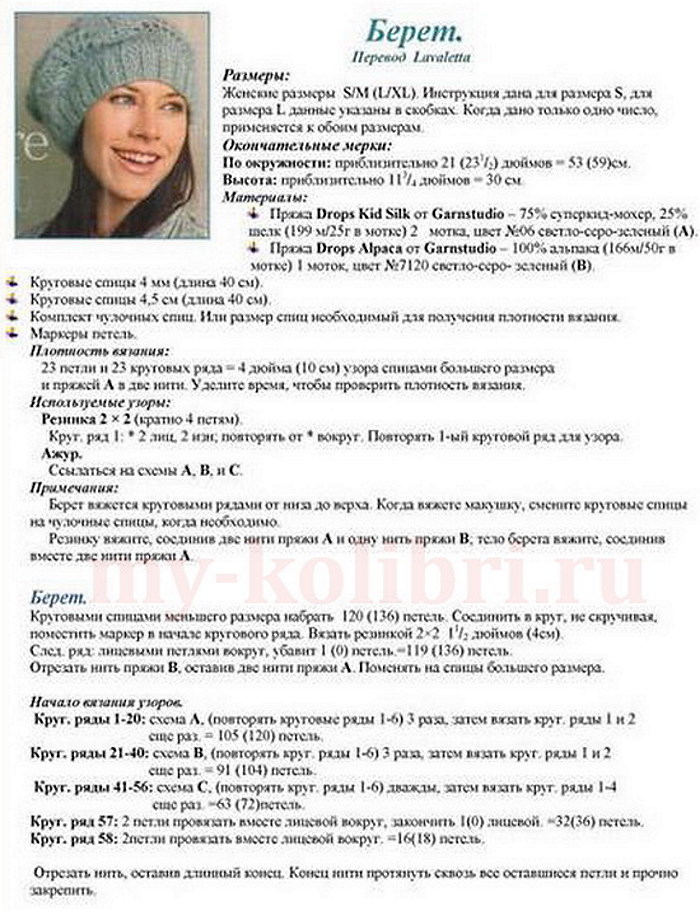
You can knit a cream scarf and white mittens to go with the beret, trimming them with fluffy fur. Such accessories go well with dark and light outerwear.
Purple-red mohair beret
A stylish purple-red knitted beret is an elegant accent that adds brightness and freshness to an everyday casual look. Designers recommend wearing it with a white or cream jacket, elegant coats of basic shades and a fur coat. Such an accessory can be decorated with a small brooch.
Emerald mohair beret
An emerald-colored beret with patterns will add texture to a fashionable look. This color looks expensive and noble. It is worn with a scarf that has a smooth fabric or a silk scarf. This bright headdress will complement an orange faux fur coat, a mustard-colored coat or a black jacket.
Mohair beret with lurex
The model, knitted with mohair thread with the addition of lurex, looks unusual. It suits an elegant fur coat or coat, a jacket made of fabric in a Windsor check. Such a beret is also worn with a tweed suit, a mini dress trimmed with flounces, a tulle outfit.
Voluminous mohair beret
A voluminous knitted headdress is an unusual accessory. This stylish beret will suit a loose coat, an oversized down jacket, or a fur coat. It will perfectly complement a flowing chiffon dress, an elongated fitted jacket, or a trouser suit. It goes well with a checkered shirt jacket, a pleated skirt, or a loose cardigan.
Mohair beret with pompom
A beret decorated with a pompom will be a great alternative to a beanie hat. Just make sure that this detail is not too large or too small.
Mohair beret with color blocks.
The color block model looks unusual and stylish. Basic muted tones look beautiful. They are paired with plain scarves with a smooth texture, simple leather or suede gloves and minimalist bags.
Beret with a visor.
A headdress, complemented by a visor, should be voluminous enough to look organic with a puffer jacket and oversized outerwear.
Khaki mohair beret
Khaki is one of the trendy shades of the last few seasons. Such berets are worn under quilted coats, evening dresses, two-piece suits of the same tone. Stylists suggest complementing an elegant fur coat, a feminine coat, a street-style jacket with a headdress. It also suits a sheepskin coat or a down jacket.
Selection of yarn and knitting needles
It is not difficult to knit a mohair beret with knitting needles if you carefully study the description of the creation of the headdress. But before you start working, you should select the necessary materials and tools. Usually, the thread is chosen based on its density and the intended pattern of the product.
- It is preferable to create openwork items from thin fiber, where in a skein there are 100 g / 450 - 500 m. This way the product will be more airy and lacy.
- For Aran weaves, the following yarn is suitable: 1 skein weighing 100 g / 350 – 400 m.
- For knitting with garter stitch or any satin stitch, threads of a denser structure are suitable.
Useful information! Craftswomen advise choosing single-color yarn to create complex weaves and lace.
The usual knitting method is preferable to use if the items are knitted from melange. According to experienced craftswomen, the combination of different shades and intricate patterns in one product looks tasteless, since they “clogged” each other.
- The tools are selected taking into account the diameter of the thread. The fiber is bent in half, and the resulting volume is compared with the diameter of the knitting needle. The manufacturer's recommendations are also read.
- There is a tag on the skein, where the optimal number of needles is usually indicated. To determine the appropriate option, the following method is also used - several samples are made with tools of different numbers.
Conventional abbreviations in diagrams
Abbreviations:
| p. | loop |
| r. | row |
| vm. | together |
| persons. | face loops |
| pcs. | things |
| rap. | rapport |
| nak. | yarn over |
| chrome. | edge loops |
Instructions for knitting mohair berets with knitting needles
The variety of women's headwear allows you to create delicate and stylish images. There are many options for berets that you can knit with your own hands. You only need to choose the right model.
Seamless beret
Experienced knitters advise beginners to make their first items with simple patterns. Classic seamless berets are the best example. More complex variations are preferable to make as you gain skills.
In this work we used 2 skeins of yarn (composition: 20% polyester, 80% mohair) – 25 g / 125 m. Bamboo knitting needles No. 4.5. Fishing line 40 cm long. You can take the tool that is convenient and familiar to work with.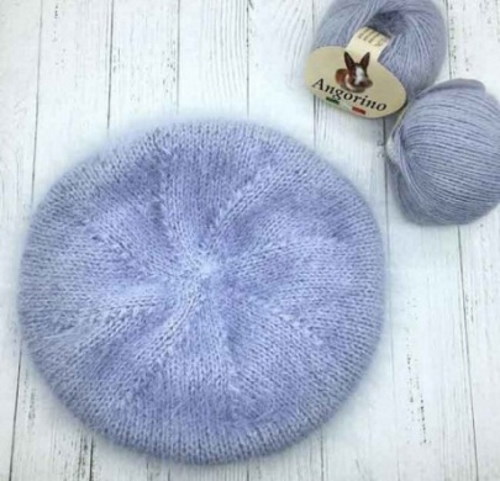
Technique of execution:
- Cast on 80 sts + 1.
- They are locked in a circle.
- 4 – 2 cm of fabric are knitted with the front surface in circular rows.
- Then they begin to make additions.
- The last knitted row is divided and marks are made after 10 sts.
- Every 11th st is marked with a marker.
- From the yarn over under the marked st and after it, add 1 st.
- This will add 16 sts to the row.
- In total there are 96 sts.
- 5 rows are knitted without adding.
- In the 6th row, repeat the same steps with additions, adding the same number of sts.
- In other words, using the method described above, add another 16 sts.
- It turns out 112 p.
- Then knit 18-20 rows with the “garter stitch” pattern. Do not remove the markers.
- Next, the paragraph is shortened.
- 2 sts are knitted together with 1 front, attaching it to the back wall, where the 1st st is marked and the 2nd follows it.
- Decreases are made every other row.
- In other words, in one row they decrease, and in the next row they knit without decreasing.
- This is how they knit as long as the length of the knitting needles allows.
- Then knit on double pointed needles, finishing by decreasing the crown.
Wedge beret
A mohair beret knitted with knitting needles (the description of the process of creating this headdress is not difficult) is also knitted in the form of wedges.
To make the pattern of the product clearly visible, here are photos of a model made of regular wool. A mohair headdress will look more romantic and airy. However, it is much warmer than a woolen one. You will need circular and hosiery knitting needles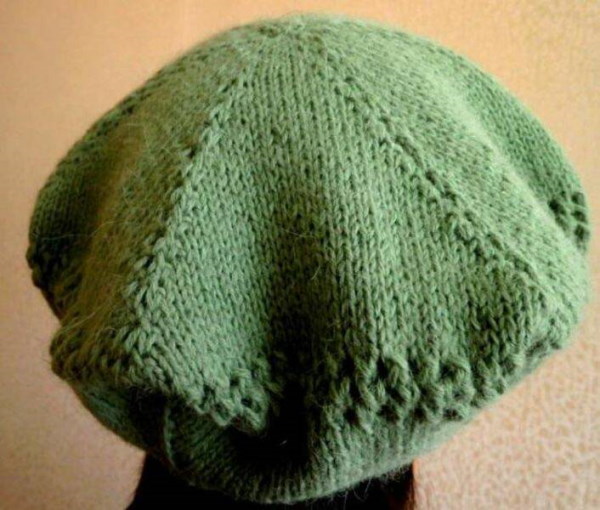
The product is knitted with the front surface, and decorated by knitting a couple of rows with the "mesh" pattern. The pattern repeat is that the first 2 sts are knitted together with knits and a drawstring + yarn over. In the even row, only knits are performed.
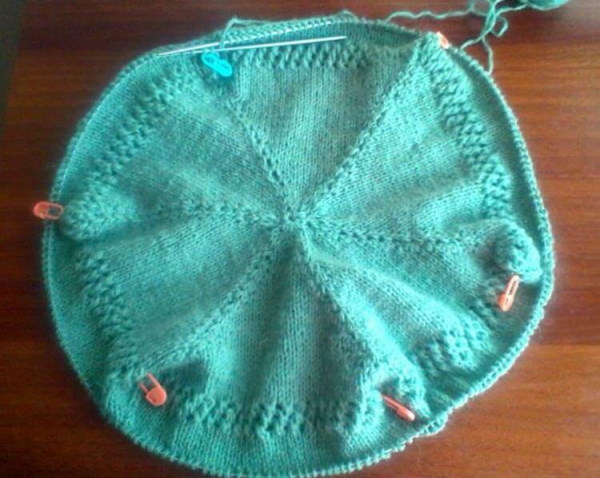
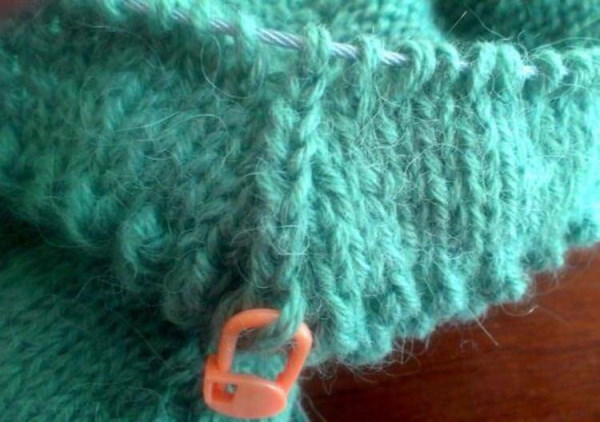
Procedure:
- Make a set of 12 sts.
- They are divided into 4 spokes.
- On the 1st and 3rd needles 2 sts.
- On the 2nd and 4th needles there are 4 sts.
- They are locked in a circle.
- 1st row: knit only faces.
- 2nd row: loops are increased by 2 times. From the 1st st. 2 are knitted.
- One st is knitted through the front wall and is not removed from the left knitting needle.
- The second stitch is knitted behind the back wall.
- On the 1st and 3rd needles, the loops are divided equally, separated with markers.
- You will get 6 segments.
- In each such sector there are 4 points.
- The main fabric is knitted. In odd rows, the outer loops are doubled. Even rows are knitted according to the pattern.
- If the item becomes uncomfortable to knit on double-pointed needles, it is transferred to circular needles.
- When you have knitted a circle with a diameter of 12 cm, knit the mesh part - 2 cm.
- The knitting ends with a medallion 14 cm in circumference.
- Then the loops are decreased.
- In all odd rows, in the diagonals separating the segments from each other, knit 3 sts in such a way that the central part can be positioned above the outer ones.
- This is how 6 cm are knitted.
- Next, knit a hollow double elastic band.
- It is permissible to insert an elastic cord into it.
- Finally, the loops are closed using a knitted stitch.
Openwork beret
A mohair beret with knitting needles (the description will help you knit a beautiful product) is also created using the openwork technique. The accessory turns out to be unusually feminine. For this model, yarn weighing 50 g / 240 m was used. Its composition was as follows - 10% polyamide, 15% mohair, 75% acrylic. Circular or straight knitting needles No. 2.5.
Procedure:
- Cast on 90 sts.
- 2 cm knit with 1X elastic
- When knitting the final row, the number of loops is increased to obtain the necessary expansion of the “dome” of the product.
- The number of loops is related to the rapport of the openwork pattern used to knit this headdress.
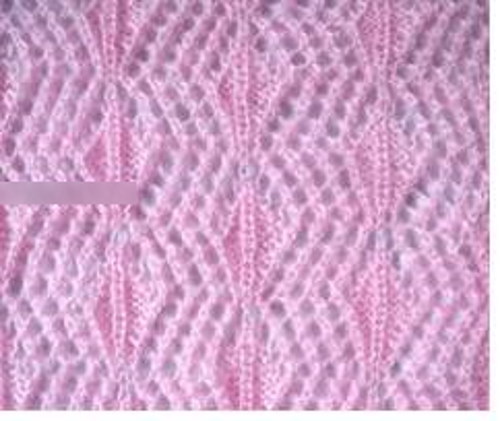
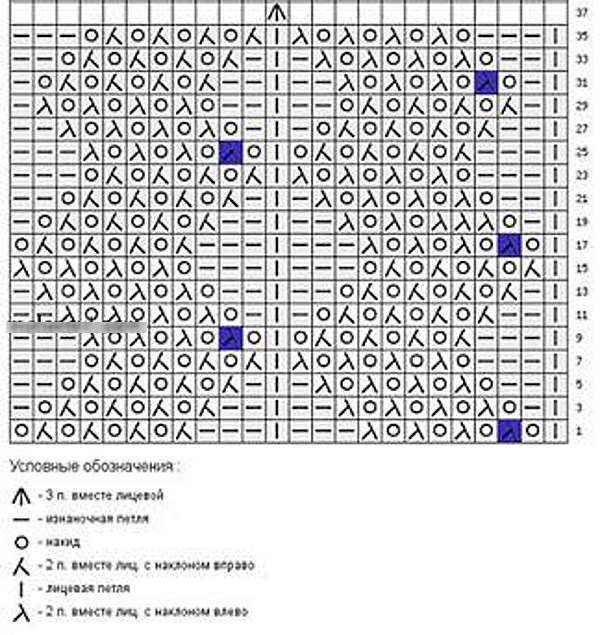
- There are 24 sts in the pattern, so their number is increased to 170 pcs.
- This is 7 rap + 2 edge.
- In other words, 24×7=168 p.
- This beret turns out to be quite voluminous. Therefore, the number of raps is reduced to 6 if you want to reduce the splendor of the product.
- In this model, 80 sts are added to the 90 sts of the elastic band.
- Next, knit according to the pattern, starting with half a diamond in a vertical pattern.
- The fabric is knitted to the required length.
- The entire pattern is done in height, plus another small “diamond” is knitted.
- The required height of the product is obtained.
- While knitting the last “diamond”, begin to decrease the loops.
- Continue to decrease the number of stitches in the final “diamond”, which is not on the diagram.
Decreasing stitches
Having knitted the required length, they then knit with the “front surface”. This is where the reduction of the loops is completed.
They are reduced in this way:
- 2 sts together are knitted through the row.
- When only 15 sts remain, they are pulled together with thread.
- Then the headdress is sewn along the side seam.
Warm winter beret
A mohair beret with knitting needles (the description will help you create a warm and beautiful accessory) for winter is quite easy to knit. This model is knitted in a circle. The headdress is double, and therefore the lining is knitted first.
Technique of execution:
- Cast on 16 sts onto the knitting needles and close in a circle.
- 1st row knit.
- In the 2nd row, begin adding to form 8 wedges.
- Knit 2 sts, yarn over and so on until the end of the row.
- 3rd row: persons again.
- In the 4th row, knit 3 knits, yarn over, and repeat until the row ends.
- Then continue making additions.
- There should be 30 sts on 4 knitting needles. A total of 120 sts.
- Then knit 15 rows without adding sts.
- Then the loops are decreased.
- There should be 60 sts left on all needles.
- Then the loops are added again up to 144 sts.
- Then knit the height of 7 rows.
- Then decrease up to 16 sts.
- They are pulled together, and the cut thread is hidden inside the product.
Voluminous beret
The size of the product is 64 cm. The yarn containing 50X50% mohair and acrylic is suitable for work. Skein 100 g / 430 m. Use knitting needles No. 5.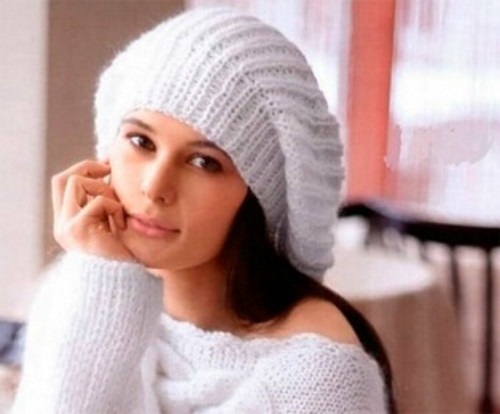
Procedure:
- Cast on 71 sts.
- 21 rows knit with 1X elastic
- In the 22nd row, add 34 sts evenly.
- It turns out 105 p.
- Next, 20 rows are done with a 1X elastic pattern.
- Having reached row 43 from the cast-on edge, the loops are increased by another 34 units.
- 139 sts are collected on the needles.
- Then continue to do 14 rows, knitting the elastic band 1X
- The fabric is knitted up to 57 rows.
- In this row, every 2 knits are knitted together.
- 105 sts remaining.
- Then the 10th row is knitted with a 1X elastic pattern.
- In the 67th row, 2 sts are again knitted together as if they were knitted together.
- 71 points remain.
- Next, row 8 continues knitting with 1X elastic
- In the next row, make a double decrease to the end of the row.
- There are 8 sts left on the needles.
- Now the last sts are gathered onto a thread. It is tightened and secured.
- The product is sewn along the side seam.
Berets knitted from mohair with knitting needles for women of different ages do not have complex patterns and descriptions.
Video about mohair beret
Beret made of mohair with pearl pattern:
